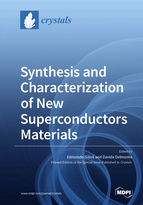Synthesis and Characterization of New Superconductors Materials
A special issue of Crystals (ISSN 2073-4352). This special issue belongs to the section "Inorganic Crystalline Materials".
Deadline for manuscript submissions: closed (31 March 2020) | Viewed by 22052
Special Issue Editors
Interests: CIGS-based solar cells; thin film deposition; high pressure synthesis (HP/HT)
Special Issues, Collections and Topics in MDPI journals
Interests: Multiferroics; high-pressure/high-temperature synthesis; magnetic/electric characterization; ferroelectric characterization; mechano-chemistry; ferro-photovoltaic materials; superconductor materials
Special Issue Information
Dear Colleagues,
In recent years, the saturation of the scientific interest in high-Tc superconductor perovskites, i.e., cuprates, was accompanied by a new stream of works based on new families of compounds showing high critical temperature superconductivity, i.e., intermetallic borides (e.g. MgB2), iron–nickel-based superconductors (La(Fe,Ni)(Pn,Ch)O, (Pn,Ch= pnictide or chalcogenide ions), heavy fermion superconductors (e.g., CeCoIn5), and superhydrides systems (e.g., H3S). These discoveries revitalized the research in this field mainly for what concerns the fundamental aspects (synthesis, characterization, and modeling). Conventional BCS model is often the appropriate model to describe superconductivity but there are several important exceptions; at the same time, the role of crystal symmetry, the presence and type of magnetic ions in the structure, and the effect of external stimuli (i.e., the application of high isostatic pressures), seems to significantly affect the critical temperature. This Special Issue aims to attract scientific contributions providing new insights and advances in the synthesis and characterization of novel superconductor materials, addressing multiple aspects of the overall physical/chemical problem, specifically the following:
- Synthesis and structural analysis
- Magnetic and/or electric characterization of the superconductive transition
- Structural effects on superconductivity
- Effect of magnetism on the superconductive state
- Role of crystal symmetry
- TC dependence on external stimuli and/or non-ambient conditions
- Theoretical modeling
Dr. Edmondo Gilioli
Dr. Davide Delmonte
Guest Editors
Manuscript Submission Information
Manuscripts should be submitted online at www.mdpi.com by registering and logging in to this website. Once you are registered, click here to go to the submission form. Manuscripts can be submitted until the deadline. All submissions that pass pre-check are peer-reviewed. Accepted papers will be published continuously in the journal (as soon as accepted) and will be listed together on the special issue website. Research articles, review articles as well as short communications are invited. For planned papers, a title and short abstract (about 100 words) can be sent to the Editorial Office for announcement on this website.
Submitted manuscripts should not have been published previously, nor be under consideration for publication elsewhere (except conference proceedings papers). All manuscripts are thoroughly refereed through a single-blind peer-review process. A guide for authors and other relevant information for submission of manuscripts is available on the Instructions for Authors page. Crystals is an international peer-reviewed open access monthly journal published by MDPI.
Please visit the Instructions for Authors page before submitting a manuscript. The Article Processing Charge (APC) for publication in this open access journal is 2600 CHF (Swiss Francs). Submitted papers should be well formatted and use good English. Authors may use MDPI's English editing service prior to publication or during author revisions.
Keywords
- New superconductors
- crystallography
- non-ambient conditions
- magnetic and electric characterization
- BCS theory







